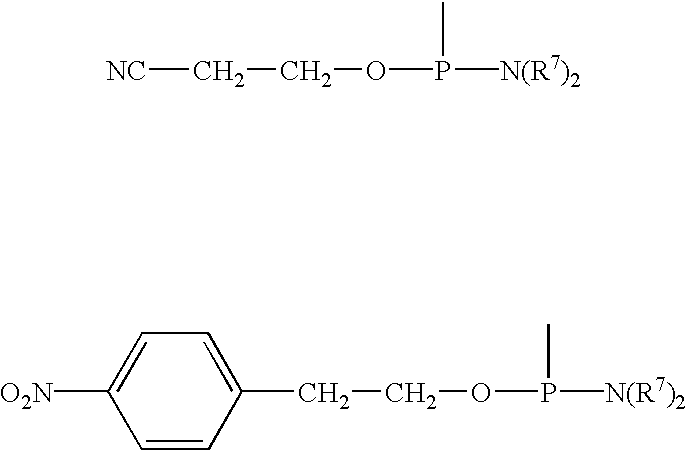Nucleoside derivatives with photolabile protective groups
a technology of protective groups and nucleoside derivatives, which is applied in the direction of sugar derivatives, aminosugars, biochemical apparatus and processes, etc., can solve the problems of insufficient protection the deprotection of the relevant nucleoside or nucleotide derivatives is still comparatively slow and incomplete, and the protective group is not significant enough to achieve byproducts
- Summary
- Abstract
- Description
- Claims
- Application Information
AI Technical Summary
Problems solved by technology
Method used
Image
Examples
example a.1
3-acetylamino-1-ethylbenzene (1) [I]
[0036] [I] H. Wieland und L. Homer, Liebigs Ann., 536, 89 (1938)
[0037] With cooling in an ice bath, 27 g (25 ml, 0.22 mol) of 3-ethyl aniline are added to 100 ml of acetic acid anhydride. After 10 minutes in the ice bath, the mixture is stirred at room temperature for a further 20 minutes and then concentrated as far as possible by means of a rotary evaporator. The raw product (36.6 g) is purified by distillation under high vacuum. 32.1 g (0.2 mol, 89%) of (1) are obtained as a slightly yellowish solid having a boiling point of 110 to 114.degree. C (0.05 mbar).
[0038] Physical data of (1): M.P.: 30-32.degree. C. (Lit [I]: 33-34.degree. C.) DC (silica gel, PE / EE 1:1): R.sub.f=0.42 .sup.1H-NMR (250 MHz, CDCl.sub.3): 7.60 (s(br), 1H, NH), 7.34-7.16 (m, 3H, arom. H), 6.92 (d, 1H, arom. H), 2.59 (q, 2H, CH.sub.2), 2.14 (s, 3H, COCH.sub.3), 1.18 (t, 3H, CH.sub.3) UV spectrum (MeOH). .lambda..sub.max [nm] (log .epsilon.): 206 (3.41), 242 (3.10), [280 (1.7...
example a.2
[0039] 5-amino-l -ethyl-2-nitrobenzene [I] (2),
[0040] 3-amino-1-ethyl-2,4-dinitrobenzene (3),
[0041] 3-amino-1-ethyl-2,6-dinitrobenzene (4) and
[0042] 5-amino-1-ethyl-2,4-dinitrobenzene (5)
[0043] [I] H. Wieland und L. Homer, Liebigs Ann., 536, 89 (1938)
[0044] For this reaction, a KPG stirrer is recommended! 15 g (92 mmol) of 3-acetylamino-1-ethyl benzene (1) are added to 70 ml of concentrated sulfuric acid cooled to -20.degree. C. in such a manner that the temperature remains below 0.degree. C. Then 9.5 g (6.2 ml, 0.15 mmol) of fuming nitric acid are added dropwise over 30 min. in such a manner that the temperature does not rise above -3.degree. C. After one hour of stirring in the ice bath, the reaction mixture is poured onto ice, neutralised with solid sodium carbonate and extracted once with 400 ml and twice with 200 ml each of Et.sub.2O. After drying over Na.sub.2SO.sub.4 and rotation, the brown oil obtained is heated to boiling point for two hours with 100 ml of conc. HCl. After ...
example a.3
5-chloro-1-ethyl-2-nitrobenzene (6)
[0049] 1,66 g (10 mmol) of 5-amino-1-ethyl-2-nitrobenzene (2) are dissolved in a 60.degree. C. mixture of 5 ml of conc. HCl and 25 ml H.sub.2O and cooled rapidly in an ice bath. At a temperature below 5.degree. C., diazotisation is carried out with 760 mg (11 mmol) of sodium nitrite in 10 ml of H.sub.2O. After 10 minutes, a pinch of urea from a spatula is added and the mixture stirred for another 5 minutes in the ice bath. This reaction mixture is poured into an 80.degree. C. solution of 1.5 g of copper(I) chloride in 10 ml of conc. HCl and 5 ml H.sub.2O which results in considerable evolvement of gas. The solution is held at this temperature for another 30 min. After cooling, the reaction solution is extracted three times with 50 ml each of EE and the combined organic phases washed with 50 ml each of NaOH and H.sub.2O. After drying over Na.sub.2SO.sub.4, concentration by means of a rotary evaporator is carried out. The crude product is placed on s...
PUM
| Property | Measurement | Unit |
|---|---|---|
| temperatures | aaaaa | aaaaa |
| temperatures | aaaaa | aaaaa |
| boiling point | aaaaa | aaaaa |
Abstract
Description
Claims
Application Information
 Login to View More
Login to View More - R&D Engineer
- R&D Manager
- IP Professional
- Industry Leading Data Capabilities
- Powerful AI technology
- Patent DNA Extraction
Browse by: Latest US Patents, China's latest patents, Technical Efficacy Thesaurus, Application Domain, Technology Topic, Popular Technical Reports.
© 2024 PatSnap. All rights reserved.Legal|Privacy policy|Modern Slavery Act Transparency Statement|Sitemap|About US| Contact US: help@patsnap.com










